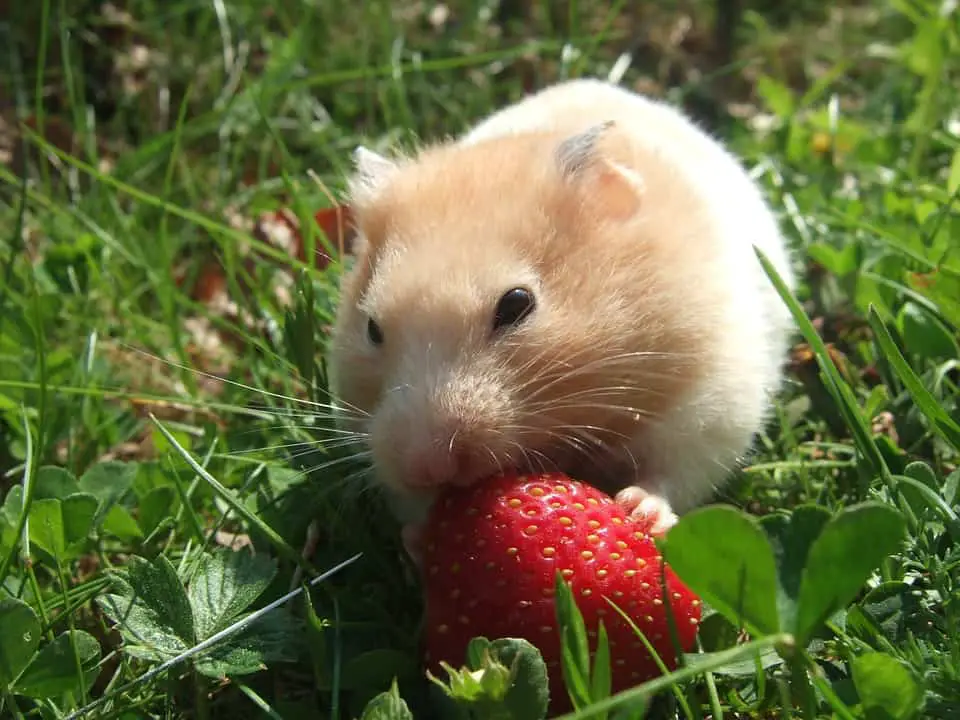
Hamsters have a reputation for being easy pets for beginners, especially for families with children. Are hamsters really good pets for young kids, toddlers, and preschoolers, in particular?
Hamsters are not ideal for children younger than 5 years old due to health concerns, and behavioral issues. Hamsters can be good pets for kids of early school age and older. These animals are bright, fun to watch, and relatively easy to maintain.
HAMSTERS FOR YOUNG KIDS: 13 CONSIDERATIONS
1. Hamsters Sleep During The Day And Stay Up At Night
Consider the crepuscular sleeping cycle of hamsters.
Some hamsters get used to being somewhat active during at least a portion of the day. They still are, however, predisposed to being idle in the daytime and waking up at dusk. This schedule is most natural for these animals.
If your child becomes frustrated and tries to play with their pet while the hamster is trying to rest, the animal could bite in response.
Your hamster could also make some noise at night by squeaking and exercising in its wheel. Some kids do not mind the soft background noise but this could be an issue if your child is a light sleeper. Of course, the habitat can also be placed away from sleeping children if needed.
2. Hamsters Are Easily Startled
Since hamsters are nocturnal, or crepuscular, their vision is not very acute and they do not rely on their vision as much as one might expect.
When you approach your hamster, it might be a good idea to talk to the animal before taking it into your hands. Letting your pet know you are there will make it less likely to get startled.
Older children understand and respect simple instructions and will probably be careful enough with their hamsters. Young kids, however, may not listen or may forget, and they could easily frighten their pets.
3. Hamsters Bite
Since these generally sweet animals become startled so easily, they are quick to bite.
It is worth noting that pretty much any pet can bite if the conditions are right. Hamsters are just so little and cute that many people simply do not expect them to respond that way.
If your hamster is new to your household:
- When you bring your hamster home from a store or rescue shelter, let it explore the habitat for a few days.
- Make sure it is eating and voiding appropriately – that will tell you that the animal is not very stressed. Then you can approach your new pet.
- Pet the hamster and see how it responds. Feed your pet from your hand a few times.
- Finally, pick it up gently and let it feel contained and cozy, so the animal eventually learns to associate you with comfort and safety.
Teach your child to treat the hamster the same way. A problem with very young kids, of course, is that they are not always receptive to instructions from their parents.
4. Health Considerations For Kids Under Five
The CDC does not recommend rodent pets for children under 5 years old.
Therefore, from a safety perspective, hamsters are more suitable for kids older than 5.
The reason the agency raises the concern is that toddlers and young kids, in general, are at a higher risk of contracting a virus or bacteria:
- Young kids have immune systems that are more vulnerable to bacteria and viruses due to being more naive.
- Very young children also do not understand the concept of hygiene yet. They are more likely to expose themselves by putting their hands, toys, or pacifiers into their mouths.
5. Some Breeds Are More Affectionate Than Others
If you are getting a hamster from a store, ask about the characteristics of the breed you are about to purchase. Some breeds are friendlier than others.
If you are adopting your new pet from a shelter, you might be provided with observations from shelter staff and volunteers about the animal’s personality and behaviors.
Some of the most popular breeds are Syrian and Russian Dwarf hamsters:
- Both breeds are very friendly to people.
- Syrians usually have to live solo in their habitats. They will not want a hamster friend.
- Russian Dwarves are much more accepting of fellow hamsters but they breed easily, so get them a friend of the same sex.
6. Hamsters Dislike Being Held
If you are looking for a cuddly pet for your kiddos, a hamster might not be ideal.
Generally, hamsters do not like being held and snuggled. They have a prey mentality and solitary personalities in general. Your hamster might hide a lot, too.
- If you try to hold your hamster, your pet could freeze and stop moving, or could try to run away. Some hamsters will bite in response to being overstimulated by touching.
If your hamster is new to your home, avoid picking it up unless you have to. Eventually, your hamster might do well with being held but avoid petting and overstimulating the animal. Instead, keep your pet contained so your furry friend feels safe.
7. Hamsters Are Quite Smart
It is not a common notion but hamsters are quite smart.
They have high spatial and instinctive intelligence. Hamsters are also capable of learning behaviors, or skills, which is something children love. Hamsters can be conditioned to know their names, too.
These pets’ bright minds and curiosity suggest that they need toys and mental stimulation to prevent boredom. A hamster might like to explore its environment and walk outside its cage once in a while. They do need supervision due to being infamous for getting away.
It is important to provide a cage that is ample and comfortable, and some toys for your hamster.
8. Hamsters Are Prone To Running Away
Hamsters are easily lost and they are infamous for running away. Some are even sagacious enough to figure out how to open their cage.
These pets are so small that they could easily become lost in your own home. If that happens, consider anything your hamster could fit into or under for a potential hiding spot. It could take you days to find a hamster. It complicates matters that a lost hamster is probably just sleeping in its hiding spot during the day and may not move around much till it is dark.
9. Hamsters Have A Short Lifespan
This might be a positive for some families who do not want a long commitment. For most households, however, the prospect of losing their pet only a couple of years after welcoming it is hard to face.
10. Many Household Cats And Dogs Prey On Hamsters
Hamsters are often perceived as prey by cats and dogs. They are small and vulnerable and are easy to attack for many bigger animals.
This is not an issue if you do not have and do not intend to have other pets at home for some time. But if you think your child is likely to talk you into getting a dog or a cat sometime soon, then this is something to be mindful of.
11. Hamsters Are Relatively Easy To Maintain But They Need More Care Than Many New Owners Expect
This is one of the most common reasons parents opt for hamsters as pets for their children: they believe that it is easy to take care of a hamster.
Taking care of a hamster could become a great chore for your kids if they are old enough. Feeding the pet and doing some cleaning teaches children responsibility and empathy. The amount of care associated with having a hamster is suitable for a responsible middle school-age child.
A hamster’s food needs to be changed daily, and they should not be overfed for their own safety. Hamsters also need their bedding changed regularly and their cage cleaned, too. The chore of cleaning the entire cage, which is usually done weekly, is once where adult supervision is important.
These pets still do need a responsible caretaker, so if your child is just learning to be responsible, provide him or her with plenty of support, for everyone’s benefit.
12. Hamsters Are Relatively Inexpensive to Maintain
Hamsters do not cost much to welcome and maintain.
- A hamster typically costs about 15$, if you are in the U.S. and plan to get your hamster from a pet store.
- The supplies include a spacious enough cage, bedding, a wheel, toys (especially chew toys), and food.
- Your hamster should see a veterinarian once a year, to check for parasites, among other things. So, the annual visit to the vet and any additional medical needs could add to your bill.
13. Hamsters Are Sweet Companions
Docile, sweet, and generally not needy for attention, these pets make great companions for school-age children.
An older child will probably love taking care of the hamster, and learning and telling their friends about their pet.
Almost any animal could become a therapy one for a particular child, even without having the actual designation of a therapy pet. And it is just a matter of personal preference regarding what animals are most congenial to your child.
A hamster can have a positive impact on children with anxiety, and social adjustment issues, and just any child who takes care of and learns from living with sentient creatures.
IN CONCLUSION
Hamsters Are Not For Kids Under 5
Although hamsters seem so ideal and easy for a small child, for the safety of both the kids and the hamsters, it is best to opt for another animal or to wait for a few years.
These pets are too fragile and can easily be injured by a kid by accident. Hamsters could bite the child out of fear, too. Rodent pets are also not ideal for young kids, for infection prevention purposes.
Hamsters Are Great For School-Age Kids
Older children, however, could do very well with a hamster. Any animal at home teaches children a lot about the world in general and how to be kind and responsible.
Older kids are more receptive to the peculiarities of a hamster’s sleeping routine. They will likely practice caution when handling their pets. As for watching the hamster exercise in its wheel, feeding it off one’s hand, and playing with the animal – all those activities are delightful for older children.
As always, consider checking your local shelter for any hamsters they might have. Shelters often run rescue operations, so they could have a variety of young hamsters needing a home.
Recent Posts
If you are new to hamsters as pets, you might find yourself in a position to wonder why your hamster hides so much. Hamsters like to borrow because they instinctively hide from predators in their...

